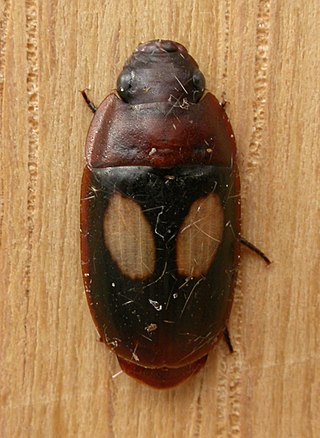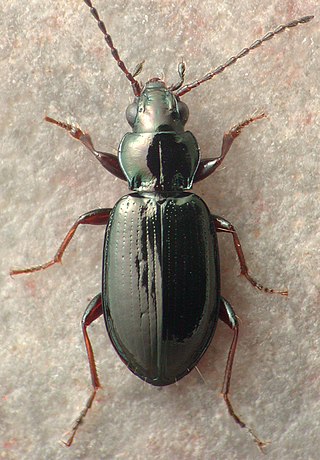Related Research Articles

Guatemalteca is a genus of beetle in the family Carabidae. As of 2017, its only described species is its type species, Guatemalteca virgen. When Terry Erwin named the genus in 2004, he placed it in the tribe Lachnophorini; in 2014 he and Laura S. Zamorano placed it in the subtribe Eucaerina.

Pseudomorphinae is a subfamily of ground beetles in the family Carabidae. There are about 12 genera and at least 360 described species in Pseudomorphinae.

Scaritinae is a worldwide subfamily of beetles in the family Carabidae, containing more than 2400 species in over 140 genera.
Halocoryza acapulcana is a species of brown coloured ground beetle in the subfamily Scaritinae which can be found in Ecuador and Mexico.
Halocoryza whiteheadiana is a species of brown coloured ground beetle in the subfamily Scaritinae which is endemic to Baja California Sur, Mexico.
Halocoryza maindroni is a species of brown coloured ground beetle in the subfamily Scaritinae which can be found on Comoros, Madagascar, Mauritius, Mayotte, and Réunion, as well as in Djibouti, Saudi Arabia, and Somalia.
Halocoryza arenaria is a species of brown coloured ground beetle in the subfamily Scaritinae which was described by Darlington in 1939.

Ross Taylor Bell was an American entomologist with particular interest in the invertebrate natural history of Vermont, United States, and carabid beetles. Together with his wife, Joyce Rockenbach Bell, his work at the University of Vermont was largely taxonomic, where they described more than 75% of the rhysodine species known to science. Ross also wrote a number of seminal papers in his chosen field.
Bembidion sejunctum is a species of beetle in the family Carabidae. It is found on Saint Pierre and Miquelon and Magdalen Islands as well as in Canada and the United States.
Anchomenus quadratus is a species of beetle in the family Carabidae. It is found in British Columbia, Canada and the U.S. states such as California, Oregon, and Washington.
Stenocrepis elegans is a species of beetle in the family Carabidae. It is found in Mexico and southwestern United States.

Selenophorus parumpunctatus is a species of ground beetle in the family Carabidae. It is found in the Caribbean and North America.
Bembidion salebratum is a species of beetle in the family Carabidae. It is found in Canada and the United States.

Bembidion grapii is a species of ground beetle in the family Carabidae. It is found in Europe and Northern Asia and North America.
Anillinus depressus is a species of ground beetle in the family Carabidae. It is found in North America.

Omophron nitidum, the shiny round sand beetle, is a species of ground beetle in the family Carabidae. It is found in North America within the United States, in areas such as Indiana, Minnesota, Nebraska, Alabama and Texas. Adults are nocturnal, spending their time in burrows and leaf litter during the day. The breeding of O. nitidum takes place from March to December.
Notiophilus intermedius is a species of ground beetle in the family Carabidae. It is found in North America.

Stenocrepis elegans is a species of beetle in the family Carabidae. It is found on Cuba and Bahamas as well as in Mexico and the United States.
Abaris splendidula is a species of woodland ground beetle in the family Carabidae. It is found in Baja California as well as Arizona and Mexico. It lives in cool and dry habitats.
Lebia abdita is a species of beetle in the family Carabidae. It is found in Baja California, Arizona and Mexico.
References
- ↑ "Halocoryza Alluaud, 1919". Catalogue of Life. Retrieved 2023-04-09.
- ↑ Erwin, Terry (2011). "Halocoryza Alluaud 1919, sea-side beetles of the Indian, Atlantic (Sensu lato), and Pacific Oceans: A generic synopsis and description of a remarkable new species from Baja California Sur, México (Coleoptera, Carabidae, Scaritini, Clivinina)". ZooKeys (127): 1–13. doi: 10.3897/zookeys.127.1748 . PMC 3175127 . PMID 21998544.
- ↑ Erwin, Terry (2011). "Halocoryza Alluaud 1919, sea-side beetles of the Indian, Atlantic (Sensu lato), and Pacific Oceans: A generic synopsis and description of a remarkable new species from Baja California Sur, México (Coleoptera, Carabidae, Scaritini, Clivinina)". ZooKeys (127): 1–13. doi: 10.3897/zookeys.127.1748 . PMC 3175127 . PMID 21998544.
- ↑ Erwin, Terry (2011). "Halocoryza Alluaud 1919, sea-side beetles of the Indian, Atlantic (Sensu lato), and Pacific Oceans: A generic synopsis and description of a remarkable new species from Baja California Sur, México (Coleoptera, Carabidae, Scaritini, Clivinina)". ZooKeys (127): 1–13. doi: 10.3897/zookeys.127.1748 . PMC 3175127 . PMID 21998544.
- ↑ Erwin, Terry (2011). "Halocoryza Alluaud 1919, sea-side beetles of the Indian, Atlantic (Sensu lato), and Pacific Oceans: A generic synopsis and description of a remarkable new species from Baja California Sur, México (Coleoptera, Carabidae, Scaritini, Clivinina)". ZooKeys (127): 1–13. doi: 10.3897/zookeys.127.1748 . PMC 3175127 . PMID 21998544.